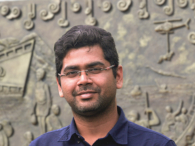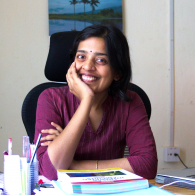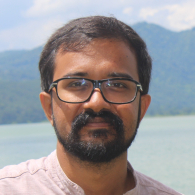Specializations
1. Antennas, Microwave Engineering and Radar Systems
-
Microwave and Millimeterwave Integrated Circuits including Antennas:
The current state-of-the-art radio frequency front end (RFFE) architecture contains different types (active and passive) of devices from microwave to millimeterwave frequencies. It includes switches and switching networks, phase shifters, filters and amplifiers after the antenna. The multiple-input-multiple-output (MIMO) antennas have been widely studied over wide band. Miniaturization has become the trend of wireless communication; the size of the antenna must be small enough to be integrated with other components. Phase shifter is used for phased array beamforming. Different types of single-pole-multi-thru (SPnT) switches are connected between antennas to main RF path in RFFE. One of the critical pain points of the RFFE is filtering. Unlike the power amplifier, where a single device can be used for multiple frequency bands, at the present time a single filter is required for each individual frequency band. Maximizing power amplifier efficiency on the uplink, and receiver sensitivity on the downlink, will require optimization of the entire RF chain. As complexity increases, it will be crucial to understand the RF chain and any interactions between elements. At IIT Palakkad, Dr. Sukomal Dey and his team are actively working on the research and development of different RFFE components utilizing Monolithic Integrated Circuit (MIC) and Micromachining platforms up to millimeterwave frequency which is funded by science and engineering research board (SERB). The team is also working on design and development of metamaterial enabled tunable absorbers and frequency selective surfaces, micromachined devices up to submillimeterwave frequency, and ultrasound transducers using piezoelectric MEMS resonators (pMUT) for RF channel selection and biomedical applications.
Faculty Members
- Dr. Sukomal Dey
- Dr. Swaroop Sahoo
2. Biomedical Signal Processing and Imaging
-
Brain Computer Interface Systems:
Brain Computer Interface (BCI) Systems translate the user’s thoughts (intentions) coded by brain activity measures into actions through a control signal without using activity of any muscles or peripheral nerves. During specific actions, thoughts, emotions and other mental tasks, unique neural activations occur in the brain from which neural signatures can be detected and translated to control commands for interfacing with external devices. These control signals can potentially be employed to substitute motor capabilities (e.g. brain-controlled prosthetics for amputees or patients with spinal cord injuries, brain-controlled wheel chair); to help in the restoration of such functions (e.g. as a tool for stroke rehabilitation), to enable alternative communication (e.g. virtual keyboard, speller etc.) for those who are disabled or otherwise unable to communicate, and other applications such as serious games for enhancing cognition skills. Researchers in IIT Palakkad are working on Brain Machine Interface (BMI) for a number of applications that include decoding motor imagery (hand/foot movement intentions), assistive and rehabilitation technology for enhancing cognitive and motor functions, neuroprosthetics, biometric identification, lie detection, emotion detection, cognitive workload assessment, low cost portable neuroimaging, etc.
-
Diagnostic Ultrasound Imaging:
Ultrasound has become an integral imaging technique in medical diagnosis due to its non-invasiveness, portability, repeatability, relative inexpensiveness, dynamic imaging capability and lack of ionizing radiation. However, achieving a perfect image quality along with a high frame rate still remains a challenge. Current diagnostics ultrasound systems are empirical systems designed for average of wide range tissue variability. In IIT Palakkad, Dr. Mahesh Panicker and his team are working on developing a tissue adaptive ultrasound system which is optimal for the tissue/region under insonification and hence leads to patient adaptive ultrasound imaging. The team is also working on the research and development of an ultrasound based affordable, portable, self-guided blood and tissue velocity imaging system to assess the cardio and cerebrovascular dynamics, which could be used like a standard stethoscope as employed by physicians, which is funded by science and engineering research board (SERB). The team also has active collaborations with Sree Chitra Tirunal Institute for Medical Sciences & Technology, Thiruvananthapuram and Kasturba Medical College, Manipal Academy of Higher Education.
Faculty Members
- Dr. Mahesh R. Panicker
3. Communication and Signal Processing
-
5G Wireless Communication and Internet of Things (IoT):
The continuously expanding needs of the data networks have led to new research and development activities in wireless communication networks to meet the ever-changing demands. This includes designing efficient architectures and techniques for the physical and media access control layers of the new generation of wireless communication systems. These systems primarily include 5G wireless networks and IoT networks. At IIT Palakkad, Dr. Jobin Francis, Dr. Lakshmi Narasimhan and their teams are working on several problems that aim to improve the practical efficiency of these systems. Specifically, we address the problems of efficient radio access network architectures, link adaptation, optimal coding and modulation, tackling high mobility in vehicular networks, low-complexity and practical transceiver algorithms for large-scale and heterogeneous wireless networks.
-
Statistical Signal Processing:
Sensor networks have become omnipresent in our current era of autonomous vehicles, remote sensing, intrusion detection, weather observation, radars, etc. Decentralized detection, estimation and multimodal data fusion are key components in these sensor networks. At IIT Palakkad, Dr. Lakshmi Narasimhan and his team are working on developing novel and low-complexity multimodal data fusion and distributed detection algorithms for various applications, each having its own system constraints.
-
Sparse Signal Processing and Machine Learning:
In big-data and large data networks, the signals dealt with have two inherent properties: large-dimensionality and sparsity. Data compression, reconstruction and parameter estimation are some of the important signal processing operations that may be required to perform here. At IIT Palakkad, Dr. Lakshmi Narasimhan and his team are using machine learning and signal processing tools to develop efficient methods for processing sparse signals.
Faculty Members
- Dr. Jobin Francis
- Dr. Lakshmi Narasimhan Theagarajan
4. Nanoelectronics, Plasmonics and Semiconductor Devices
Faculty Members
- Dr. Arvind Ajoy
- Dr. Revathy Padmanabhan
5. Power systems and power electronics
Faculty Members
- Dr. Arun Rahul S.
- Dr. Manas Kumar Jena
6. Instrumentation and Control System
Faculty Members
- Dr. Shaikshavali Chitraganti
- Dr. Sneha Gajbhiye
- Dr. Sreenath Vijayakumar
7. VLSI Systems
Faculty Members
-
Dr. Subrahmanyam Mula
Research Facilities
Laboratories / Research Centers
- Central Instrumentation Facility
- Central Micro-Nano Fabrication Facility
- Center for Computational Imaging
- Brain Machine Interface Systems Laboratory
Research Equipments
- Brain Machine Interface Systems Laboratory:
- ActiCHamp 64-channel Electroencephalograph (EEG) Amplifier, Brain Products
- EMOTIV EPOC+ 14-channel Wireless EEG
- Muse 4-channel EEG
- Mobile Workstation Dell 3520
- Center for Computational Imaging:
- Verasonics Vantage 128-channel research ultrasound system
- 64-channel airborne ultrasound system
- Vitus SIU-3 portable ultrasound imaging system
- Neurosky mindwave single channel EEG acquisition system

















